Related Research Articles
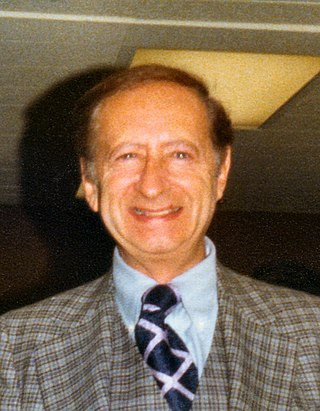
Robert Albert Bloch was an American fiction writer, primarily of crime, psychological horror and fantasy, much of which has been dramatized for radio, cinema and television. He also wrote a relatively small amount of science fiction. His writing career lasted 60 years, including more than 30 years in television and film. He began his professional writing career immediately after graduation from high school, aged 17. Best known as the writer of Psycho (1959), the basis for the film of the same name by Alfred Hitchcock, Bloch wrote hundreds of short stories and over 30 novels. He was a protégé of H. P. Lovecraft, who was the first to seriously encourage his talent. However, while he started emulating Lovecraft and his brand of cosmic horror, he later specialized in crime and horror stories working with a more psychological approach.
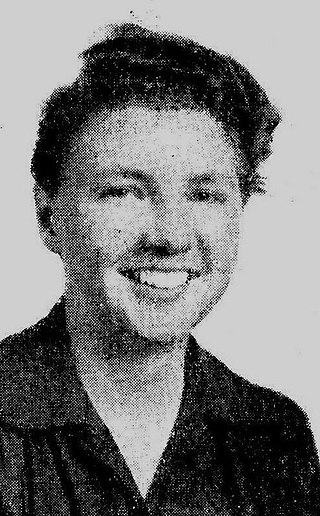
Leigh Douglass Brackett was an American science fiction writer known as "the Queen of Space Opera." She wrote the screenplays for The Big Sleep (1946), Rio Bravo (1959), and The Long Goodbye (1973). She worked on an early draft of The Empire Strikes Back (1980), elements of which remained in the film; she died before it went into production. In 1956, her book The Long Tomorrow made her the first woman ever shortlisted for the Hugo Award for Best Novel, and, along with C. L. Moore, one of the first two women ever nominated for a Hugo Award.

Marion Eleanor Zimmer Bradley was an American author of fantasy, historical fantasy, science fiction, and science fantasy novels, and is best known for the Arthurian fiction novel The Mists of Avalon and the Darkover series. She was noted for the feminist perspective in her writing.
Edward Groff Conklin was an American science fiction anthologist. He edited 40 anthologies of science fiction, one of mystery stories, wrote books on home improvement and was a freelance writer on scientific subjects as well as a published poet. From 1950 to 1955, he was the book critic for Galaxy Science Fiction.
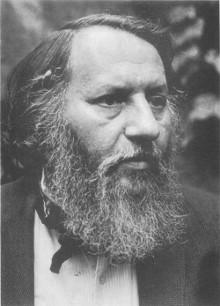
Avram Davidson was an American writer of fantasy fiction, science fiction, and crime fiction, as well as the author of many stories that do not fit into a genre niche. He won a Hugo Award and three World Fantasy Awards in the science fiction and fantasy genre, a World Fantasy Life Achievement award, and an Ellery Queen's Mystery Magazine short story award and an Edgar Award in the mystery genre. Davidson edited The Magazine of Fantasy and Science Fiction from 1962 to 1964. His last novel The Boss in the Wall: A Treatise on the House Devil was completed by Grania Davis and was a Nebula Award finalist in 1998. The Encyclopedia of Science Fiction says "he is perhaps sf's most explicitly literary author".

William Anthony Parker White, better known by his pen name Anthony Boucher, was an American author, critic, and editor who wrote several classic mystery novels, short stories, science fiction, and radio dramas. Between 1942 and 1947, he acted as reviewer of mostly mystery fiction for the San Francisco Chronicle. In addition to "Anthony Boucher", White also employed the pseudonym "H. H. Holmes", which was the pseudonym of a late-19th-century American serial killer; Boucher would also write light verse and sign it "Herman W. Mudgett".
Roger Elwood was an American science fiction author and editor, who edited a large number of anthologies and collections for a variety of publishers during the early to mid-1970s.

The Magazine of Fantasy & Science Fiction is a U.S. fantasy and science fiction magazine, first published in 1949 by Mystery House, a subsidiary of Lawrence Spivak's Mercury Press. Editors Anthony Boucher and J. Francis McComas had approached Spivak in the mid-1940s about creating a fantasy companion to Spivak's existing mystery title, Ellery Queen's Mystery Magazine. The first issue was titled The Magazine of Fantasy, but the decision was quickly made to include science fiction as well as fantasy, and the title was changed correspondingly with the second issue. F&SF was quite different in presentation from the existing science fiction magazines of the day, most of which were in pulp format: it had no interior illustrations, no letter column, and text in a single-column format, which in the opinion of science fiction historian Mike Ashley "set F&SF apart, giving it the air and authority of a superior magazine".

Kate Wilhelm was an American author. She wrote novels and stories in the science fiction, mystery, and suspense genres, including the Hugo Award–winning Where Late the Sweet Birds Sang. Wilhelm established the Clarion Workshop along with her husband Damon Knight and writer Robin Scott Wilson.
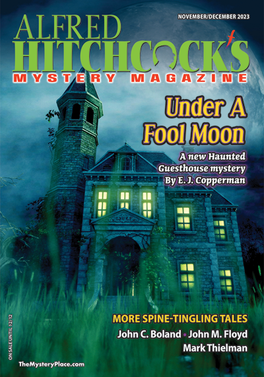
Alfred Hitchcock's Mystery Magazine (AHMM) is a bi-monthly digest size fiction magazine specializing in crime and detective fiction. AHMM is named for Alfred Hitchcock, the famed director of suspense films and television.
Digest size is a magazine size, smaller than a conventional or "journal size" magazine, but larger than a standard paperback book, approximately 14 cm × 21 cm. It is also a 13.65 cm × 21.27 cm and 14 cm × 19 cm format, similar to the size of a DVD case. These sizes evolved from the printing press operation end. Some printing presses refer to digest size as a "catalog size". The digest format was a convenient size for readers to tote around or to leave within easy hand-reach.

James Henry Schmitz was an American science fiction writer born in Hamburg, Germany of American parents.
Charlotte Armstrong Lewi was an American writer. Under the names Charlotte Armstrong and Jo Valentine she wrote 29 novels, as well as short stories, plays, and screenplays. She also worked for The New York Times' advertising department, as a fashion reporter for Breath of the Avenue, and in an accounting firm. Additionally, she worked for the New Yorker magazine, publishing only three poems for them.
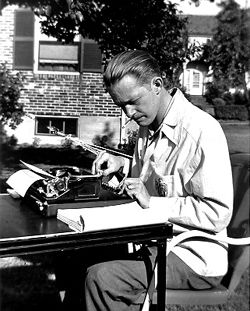
Robert Arthur Jr. was a writer and editor of crime fiction and speculative fiction known for his work with The Mysterious Traveler radio series and for writing The Three Investigators, a series of young adult novels.
John Maddox Roberts was an American author of science fiction, fantasy, and historical fiction including the SPQR series and Hannibal's Children.

An anthology series is a written series, radio, television, film, or video game series that presents a different story and a different set of characters in each different episode, season, segment, or short. These usually have a different cast in each episode, but several series in the past, such as Four Star Playhouse, employed a permanent troupe of character actors who would appear in a different drama each week. Some anthology series, such as Studio One, began on radio and then expanded to television.

Henry Slesar was an American author and playwright. He is famous for his use of irony and twist endings. After reading Slesar's "M Is for the Many" in Ellery Queen's Mystery Magazine, Alfred Hitchcock bought it for adaptation and they began many successful collaborations. Slesar wrote hundreds of scripts for television series and soap operas, leading TV Guide to call him "the writer with the largest audience in America."
Bill Pronzini is an American writer of detective fiction. He is also an active anthologist, having compiled more than 100 collections, most of which focus on mystery, western, and science fiction short stories. Pronzini is known as the creator of the San Francisco-based Nameless Detective, who starred in over 40 books from the early 1970s into the 2000s.
Jane Rice was an American science fiction and horror writer.
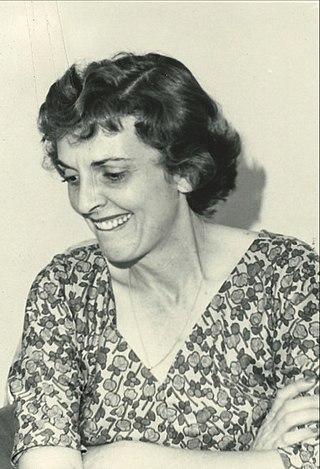
Mildred McElroy Clingerman was an American science fiction author.
References
- ↑ Science Fiction Encyclopedia website
- ↑ De Leon, Solon (1925). The American Labor Who's Who. New York: Hanford Press. p. 57.
- 1 2 3 Eric Leif Davin, Partners in Wonder: Women and the Birth of Science Fiction, 1926-1965. Lexington Books, Lanham, MD (2006); ISBN 0739112678, pp. 130, 378-79.
- ↑ MayDay Books website
- ↑ Katherine H. Adams, Michael L. Keene Women, Art and the New Deal. McFarland; Jefferson, NC. (2015); ISBN 9781476623665, pg 39.
- ↑ Writers take sides: letters about the war in Spain from 418 American authors. League of American writers, New York, (1938), pp. 18-19.
- ↑ Goodreads website
- ↑ "Humanist Manifesto II". American Humanist Association. Archived from the original on October 20, 2012. Retrieved October 8, 2012.
- ↑ CrimeTime UK website, The case of the missing rights holder
- ↑ Historical Marker Database website
- ↑ Dangerous Visions , pg. 115. (2011)